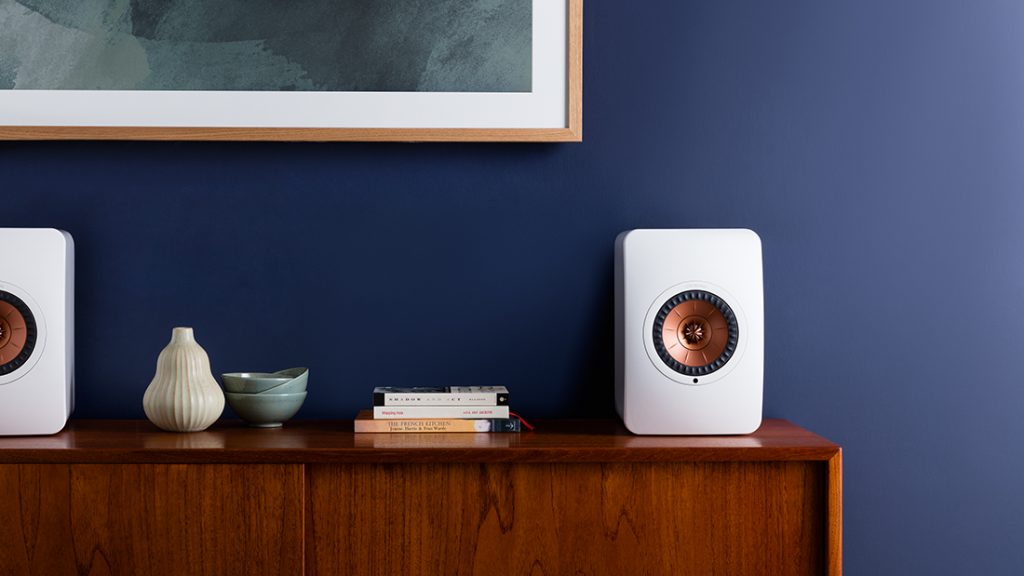KEF speakers design: The traits and technology keeping KEF at the forefront of modern loudspeaker design
Possibly the most technologically pioneering British audio brand of all time, KEF has influenced much of the world’s loudspeaker technology since its beginnings in the 1960s.
Still located on its original site in Maidstone, UK, KEF’s sound engineers and mechanical designers continue to work at the place where it all began for the company.
The hand-assembly and testing of its flagship products takes place here, too, in buildings straight out of the mid-century playbook for workshops and factories.
The site even contains a museum dedicated to its key products and the original acoustic test chambers built by founder Raymond Cooke, who named the company after the Kent Engineering & Foundry, with which his company originally shared the site.
The maverick electrical engineer found fame and fortune building some of the most cutting-edge loudspeakers of the 1960s and 1970s.
Despite the nods to history, the company, now owned by the Hong Kong-based Gold Peak Group, has never sat still in terms of the technology it products.
By the mid-1990s, it had adopted computer-driven numerical simulation, sparking a revolution in sound quality and initiating a longstanding association between the company and digital design software that continues to determine every aspect of its product development.
Today, KEF remains one of the leading companies in its field, revered for its loudspeaker driver technology that produces exquisite sound for home audio connoisseurs.
Of its many landmark inventions, arguably its most recognised is its Uni-Q driver, which takes the unique step of mounting the treble unit at the centre of the bass driver’s cone.
Because the sound comes from the same point in space, and is produced in a controlled and continuous way over the whole audio range, the Uni-Q driver manages to produce uncannily real and utterly convincing sounds.
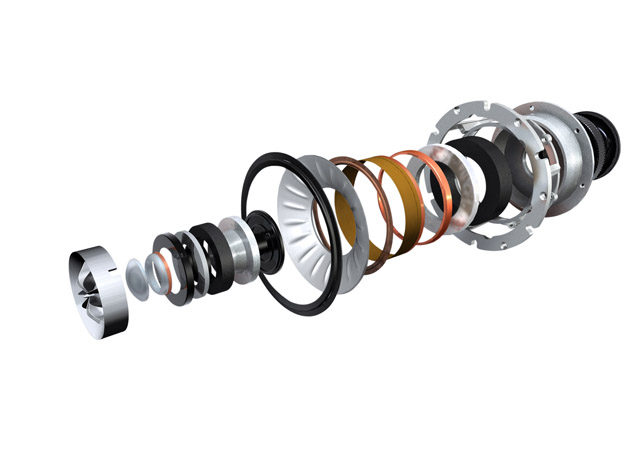

Simulating sound
The mix of tradition and innovation is a recurring theme on our visit to KEF. As he talks us through the make-up of a loudspeaker driver, KEF’s head of acoustics Dr Jack Oclee-Brown explains: “In a way, they haven’t changed in their basic principle of operation for more than 50 years.”
An electric signal comes in through the terminals, attaches to a coil of wire that’s buried in a permanent magnet, helping to convert the electric signal to mechanical movement, which moves the speaker cone. It is this movement that pushes on the air to make sound.
“The thing that’s interesting from an engineering perspective,” says Oclee-Brown, ‘“is that you can make something sound terrible, or you can make something sound marvellous with the same approach.”
KEF was among the first to make the switch from producing audio engineering calculations for its drivers by hand, to using computer-powered simulation and digitally monitored quality control.
Simulating the behaviours of a loudspeaker is a challenge, as it needs to consider four key tenants: electrical signal, magnetism, vibration, and acoustic.
“The loudspeaker industry is a small niche. There are lots of engineering tools out there, but they’re generally quite focused on one type of behaviour,” explains Oclee-Brown, opening up a file on his workstation to demonstrate this.
“When we started developing our approach from about 1995, we realised we’d have to have some in-house software to give it the correct context for what we were trying to do.”
An example is the use of commercial software PAFEC for simulating the vibro-acoustics, which is then added into KEF’s in-house software.
The proprietary software collates all the different simulation elements inputted using a ‘circuit’ user interface approach, and outputs an overlaid graph of how the different factors impact upon each other.
The goal is to balance the four-way fight between the behaviours, adjusting the shape, size, materials and placement of the driver components, in order to get the most perfectly balanced sound across all the frequencies, resulting in a consistently smooth data chart.

A sound frequency of 40,000Hz means that the thin piece of aluminium used in the tweeter dome is moving at 40,000 times a second. At this speed, a badly designed dome can begin to wobble like jelly.
“This is pretty undesirable – you can’t get good sound off the tweeter at this point,” explains Oclee-Brown, unperturbed. “That’s the beauty of this system, you now have a handle on how to improve this. We can go back in, change the size, the shape, the materials, run it again. Did it improve it? Did it make it worse?”
The rigidity created by the shape and curvature of the dome dominate the design process, given the thinness of the aluminium foil used to manufacture the part, he says. “If you use a really good material, but you don’t carefully design the shape of it, then you won’t get good performance.”
In keeping with KEF’s heritage of experimenting with new materials, the designers are continually looking at new ways of producing cones, domes and frames, but manufacturability remains key.
“One key thing about aluminium is that it’s very nice to form,” says Oclee-Brown, holding up a thin slither of polished metal from a tweeter. “When you make this dome, you can form the vertical walls on it. It’s a total cylinder and that adds a lot of strength.”
While some materials might boast of being ‘ten-times stronger than aluminium’, often they are discounted, because they are unable to be formed as well as existing methods, producing stresses that compromise the sound.
Top volume
The simulations focus not only on driver behaviour, but also the influence on sound output from cabinets, ports, crossovers and other elements.
“We end up with geometry: the dome should be this shape, the cone should be this shape, the box should have bracing here,” says Oclee-Brown. “Once we’re at that point, it needs to be made manufacturable, and that’s where the mechanical engineering team come in,” he explains, getting up and walking to the other end of the design studio, where KEF’s two senior designers, Phil Gidley and Mark Burdett, are sat working.
“You see what the chaps at the other end of the office do in ‘computer land’,” says Gidley, by way of welcome, “but there comes a time where you need to create something that’s manufacturable so that you can sell it!”
Gidley and Burdett’s work is constrained primarily by the acoustic specification of how many drivers there are, where they need to be positioned and volumes, but there’s also a heavy styling element to consider.
KEF’s product line-up features speakers with some stunning aesthetics and choices of woods, metals and paint finishes that make them stand out, not just in the marketplace, but also as a luxury item in a home setting.
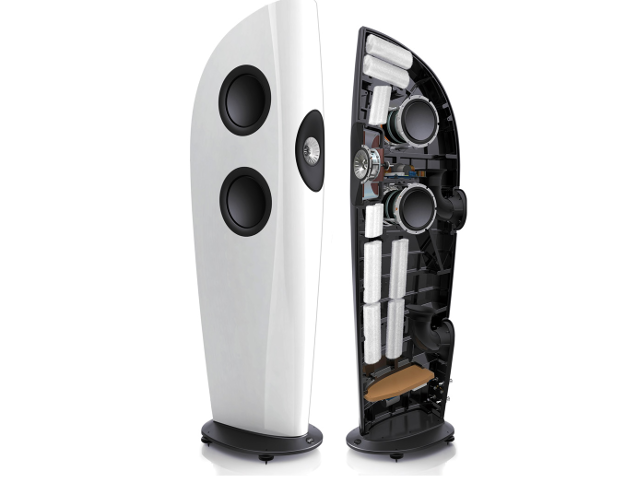
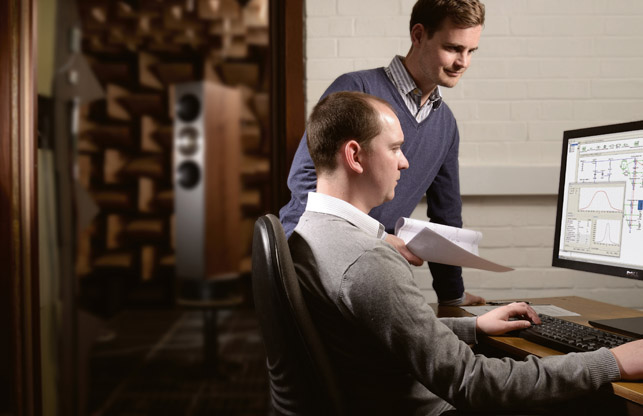
This aesthetic begins to take shape in 3D CAD designs created in Siemens NX, which allow KEF’s management and designers to initially gather around a screen and discuss how things are looking.
“At the design stage, we just use the rendering within NX, and the true shading is pretty good,” says Gidley, adding that this allows the team to make quick cosmetic decisions.
“You can get some nice continuous surfaces, especially in the Uni-Q area. A lot of work went into that area,” he says, pulling up a model of the beautifully curved KEF Blade.
With the basic shape and internal bracings in concept form, the mechanical designers can send the CAD model back and forth to simulation engineers for further FEA analysis throughout the development process.
Once the team has narrowed down the possibilities into a single idea, little time is wasted in building a physical prototype that brings lots of benefits to product development. As Gidley puts it: “Unless you can actually build something that you can listen to, that you can put drivers in, connect up to an amplifier and listen to music, then it’s all still a theory.”
The prototype parts are also useful in terms of seeing what the cabinets will look like in real light conditions, which often gives the designers new ideas.
KEF soft-tools the essential parts at its factories, adding CNC-machined wood, metal and 3D-printed parts produced locally to build a functioning unit able to validate the simulation.
Burdett explains that KEF was an early adopter of rapid prototyping, using SLA and SLS parts, as well as rapid-cast parts, nearly 19 years ago.
The team relies on parts from additive manufacturing bureau ARRK, which has worked hard over the years to satisfy KEF’s needs, so that the company hasn’t needed to invest in its own in-house 3D printer. Instead, ARRK brings a lot of skill to some of the trickier processes. Parts with thin wall tolerances, such as the Tangerine waveguide blades that sit over the tweeters, require particular care, especially in post-processing.
Says Burdett: “I can send them all off to ARRK and I know what’s coming back. We’ve always used them and the parts are high quality.”
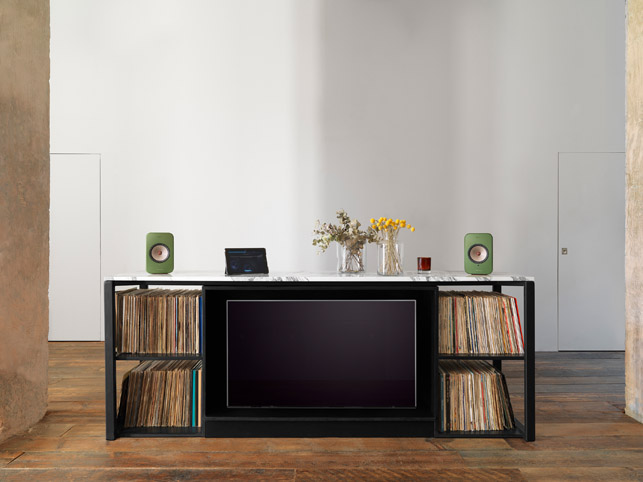
Tooling up
When it comes to manufacturing products such as its premium Blade models, each half of the tooling can cost in the region of £35,000, and even more for special editions, such as those with carbon-fibre casings. When you’re investing that sort of sum, then there’s no margin for error, says Gidley.
“You can’t squirt something of that size out to ARRK and say ‘Can I have a prototype please?’” he laughs. “You really have to drill down into the CAD to make sure you’ve got it right, take a brave pill and sign the cheque.”
With over 20 years of working in CAD, this is now second nature, but it’s also a testament to the software’s capabilities. “Projects like [the Blade speakers], if you were doing this in a 2D CAD system, you wouldn’t know that you’d made a mistake until it was too late. And also, they’ve got to interpret your CAD files,” says Burdett.
“We were just beginning to have things tooled-up offshore, so it also got rid of the language discrepancies. If we were sure that our CAD data was correct, we know the product is going to be correct.”
The 3D CAD model is also utilised by KEF’s graphics department, which handles renderings for marketing use, as well as the external design office, based in Hong Kong.
The ability to share data and designs quickly is a great help for a company that has a history of working as an OEM for other audio companies, as well as collaborating on its own projects with outside designers.
Stand-out collaborations include its giant, super limitededition Muon speakers, with exterior panelling sculpted by British designer Ross Lovegrove; its portable Bluetooth speakers with Porsche Design; and the work with Hong Kong-based product designer Michael Young Studio, which worked with KEF on its latest LSX wireless speakers.
The LSX model represents KEF’s confident steps into the modern trend of active speakers that are able to play streamed content without the need for towering amplifiers and receivers. The need to incorporate extra electronics into the speakers themselves poses new design challenges.
“Things are changing a bit because, if you look at our current product line-up, we still make passive speakers for our traditional market, but we’re now making headphones, active Bluetooth speakers and higher end active products,” says Oclee-Brown. “The number of different areas to work on in a product like that has just ballooned!”
Being part of a conglomerate of companies helps the development process move fast, giving KEF speakers design the ability to pull in expertise from teams from around Gold Peak Group specialising in electronics, streaming and software.
Yet it is the members of KEF’s UK team, with their expertise in acoustics, who make sure it all works together and continue to push back the boundaries of the kind of sound that high-end audio engineering can create.

